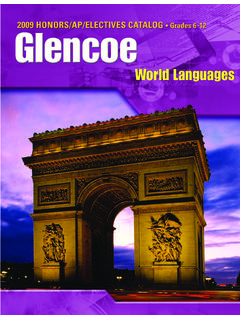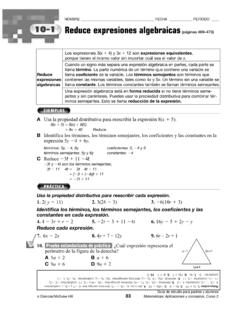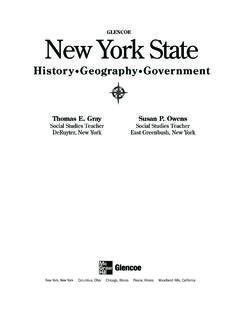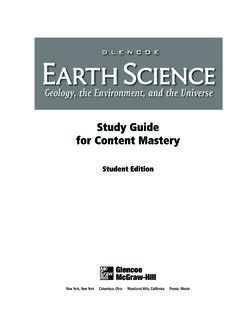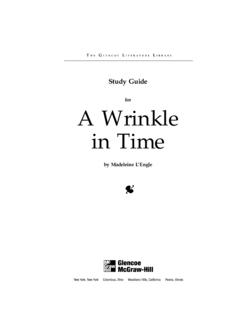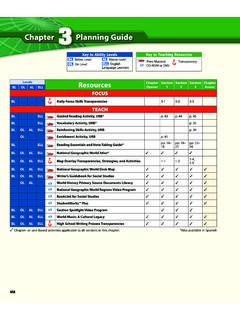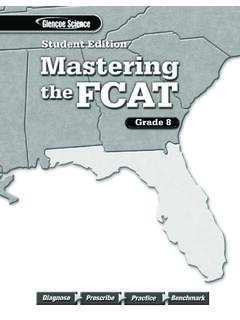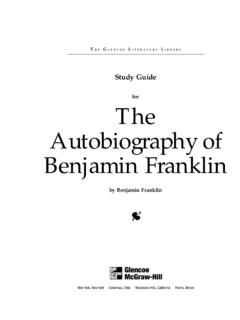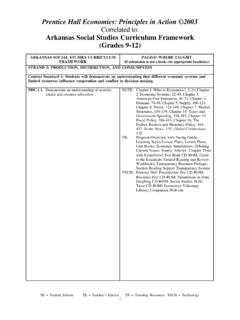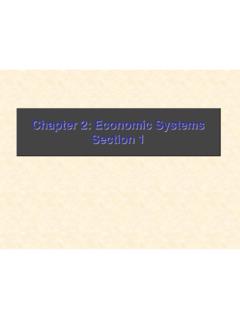Transcription of ECONOMICS TODAY AND TOMORROW - Glencoe
1 ECONOMICSTODAYANDTOMORROWR eading EssentialsandStudy GuideStudent WorkbookTO THE STUDENTThe Reading Essentials and Study Guideis designed to help you use recognized reading strategies to improve your reading-for-information skills. For each section of the student text-book, you are alerted to key terms, asked to draw from prior knowledge, organize your thoughts with a graphic organizer, and then follow a process to read and understand the text. The ReadingEssentials and Study Guidewas prepared to help you get more from your textbook by reading with by The McGraw-Hill Companies, Inc. All rights reserved. Permission is granted to reproducethe material contained herein on the condition that such material be reproduced only for classroom use; be provided to students, teachers, and families, without charge; and be used solely in conjunction withEconomics: TODAY and TOMORROW . Any other reproduction, for use or sale, is prohibited without written permission from the all inquiries to: Glencoe /McGraw-Hill8787 Orion PlaceColumbus, OH 43240 ISBN 0-07-865063-1 Printed in the United States of 2 3 4 5 6 7 8 9 1004709 08 07 06 05 04iiiCONTENTSC hapter 1 What is ECONOMICS ?
2 1 The Basic Problem in ECONOMICS .. 12 Trade-Offs.. 43 What Do Economists Do?.. 6 Chapter 2 economic Systems and the American Economy1 economic Systems.. 82 Characteristics of the American Economy.. 113 The Goals of the Nation.. 14 Chapter 3 Your Role as a Consumer1 Consumption, Income, and Decision Making.. 162 Buying Principles or Strategies.. 193 Consumerism.. 22 Chapter 4 Going Into Debt1 Americans and Credit.. 252 Sources of Loans and Credit.. 283 Applying for Credit.. 314 Government Regulation of Credit.. 34 Chapter 5 Buying the Necessities1 Shopping for Food.. 362 Clothing Choices.. 393To Rent or to Buy.. 414 Buying and Operating a Vehicle.. 44 Chapter 6 Saving and Investing1 Why Save?.. 462 Investing: Taking Risks With Your Savings .. 493 Special Savings Plans and Goals.. 53 Chapter 7 Demand and Supply1 Demand.. 562 The Demand Curve and Elasticity of Demand.. 593 The Law of Supply and the Supply Curve.. 634 Putting Supply and Demand Together.
3 66 Chapter 8 Business Organizations1 Starting a Business.. 692 Sole Proprietorships and Partnerships.. 713 The Corporate World and Franchises.. 73 Chapter 9 Competition and Monopolies1 Perfect Competition.. 762 Monopoly, Oligopoly, Monopolistic Competition.. 783 Government Policies Toward Competition.. 82 Chapter 10 Financing and Producing Goods1 Investing in the Free Enterprise System.. 842 Types of Financing for Business Operations.. 873 The Production Process.. 88 Chapter 11 Marketing and Distribution1 The Changing Role of Marketing.. 912 The Marketing Mix.. 943 Distribution Channels.. 97 Chapter 12 The American Labor Force1 Americans at Work.. 992 Organized Labor.. 1023 Collective Bargaining.. 105 Chapter 13 Measuring the Economy s Performance1 National Income Accounting.. 1082 Correcting Statistics for Inflation.. 1123 Aggregate Demand and Supply.. 1144 Business Fluctuations.. 1165 Causes and Indicators of Business Fluctuations.
4 119 Chapter 14 Money and Banking1 The Functions and Characteristics of Money.. 1212 History of American Money and Banking.. 1243 Types of Money in the United States.. 127 Chapter 15 The Federal Reserve System and Monetary Policy1 Organization and Functions of the Federal Reserve System.. 1292 Money Supply and the Economy.. 1313 Regulating the Money Supply.. 133 Chapter 16 Government Spends, Collects, and Owes1 Growth in the Size of Government.. 1362 The Functions of Government.. 1383 The Federal Budget and the National Debt.. 1414 Taxation.. 143 Chapter 17 Stabilizing the National Economy1 Unemployment and Inflation.. 1452 The Fiscal Policy Approach to Stabilization.. 1473 Monetarism and the Economy.. 149 Chapter 18 Trading With Other Nations1 The Benefits of World Trade.. 1512 Financing World Trade.. 1533 Restrictions on World Trade.. 156 Chapter 19 Converging economic Systems1 Comparing Capitalism and Socialism.. 1592 Changing Authoritarian Socialism The Case of China.
5 1613 Nations Move Toward the Market System.. 163 Chapter 20 economic Growth in Developing Nations1 Characteristics of Developing Nations.. 1652 The Process of economic Development.. 1673 Obstacles to Growth in Developing Nations.. 1694 Industrialization and the Future.. 171 Chapter 21 The Global Economy1 Reasons for and Results of Global Integration.. 1732 Direct Foreign Investment Should We Be Worried?.. 1753 Multinationals and economic Competition.. 177 Chapter 22 Cybernomics1 The Growth of E-Commerce.. 1802A New Economy? .. 1823 Issues in Cybernomics.. 184ivCopyright by The McGraw-Hill Companies, Guide1 Name Date Class economicsThe study of how people make choices about ways to use limited resources to satisfy theirwants (page 3)scarcityThe condition that occurs when wants are greater than the resources to satisfy them (page 5)factors of productionThe resources of land, labor, capital, and entrepreneurship that are used to producegoods and services (page 6) landThe economic term for surface land and water and the natural resources that each contains (page 6)laborThe human effort that is required to produce goods and services (page 6)goodsMaterial objects that satisfy people s wants or needs (page 6)servicesActions or activities that satisfy people s wants or needs (page 6)capitalManufactured goods that are used to produce other goods or services (page 6)productivityThe amount of goods and services that results from the use of a set amount of land, labor,capital, and entrepreneurship (page 7)
6 EntrepreneurshipAbility of risk-taking individuals to start new businesses or develop new products andprocesses in hopes of making profits (page 7)technologyAdvances in knowledge that lead to new and improved goods and services and better ways ofproducing them (page 8)KEY TERMSFor use with textbook pages 3 8 THE BASIC PROBLEM IN ECONOMICSDRAWING FROM EXPERIENCEAt one time or another, you have probably been required to do a project for your science, socialstudies, or art class. What materials did you use? Who did the work? Did you use tools in makingyour project? All these questions are basic to the study of section focuses on how people and societies make choices in their use of resources. Thestudy of these choices and how people make them forms the basis of YOUR THOUGHTSUse the cause-and-effect diagram below to help you take notes as you read the summaries thatfollow. Think about why people make choices in the things that they must make resources are _____1,12 Study GuideCopyright by The McGraw-Hill Companies, Date Class 11,Name Date Class READ TO LEARN Introduction (page 3) ECONOMICS is the study of how societies use limited resources to fulfill their wants and needs.
7 Wants Versus Needs (page 4)People sometimes have difficulty recognizing the difference between what they want and whatthey need. In the study of ECONOMICS , however, needs are only the basic things that a personmust have in order to survive. Everything else is a want, or is the difference between a want and a need? Choices (page 5)Because resources are limited, not everyone can have everything he or she wants. People makechoices about how to spend the money they have. Businesses make choices about what to pro-duce and when to produce it. Societies make choices about how to use their resources. In theUnited States, for example, elected representatives decide how much money to spend on defenseand how much on education. How people and societies make these choices is the focus of eco-nomics. basic economic choice must people and societies make? The Problem of Scarcity (page 5)Choices are necessary because everything that exists is limited. Even if a resource is plentiful, therestill are limits to what is available.
8 At the same time, people have competing uses for these limitedresources. The result is scarcity. Scarcity means that people do not have and cannot have enoughresources to satisfy their every want. Scarcity is the basic problem of is scarcity and why does it exist? Factors of Production (page 6)When economists talk about scarcity, they are talking about the factors of production that is,the resources needed to produce goods and services. Economists recognize the following basictypes of resources as factors of production:Copyright by The McGraw-Hill Companies, Guide3 Name Date Class economists, this term means all the natural resources present on Earth. It includesactual land surface and the plants and animals that live on the land, as well as mineraldeposits within it. Land also includes water and everything found in factor of production includes everyone who produces goodsand items that people buy. Services are activities done for others for a is manufactured goods that are used to make other goods and services.
9 Itincludes machines, buildings, and tools. Capital combines with labor to increaseproductivity the ability to produce more goods and services in better and faster refers to the ability of people to start new businesses, introduce newproducts or processes, or improve management techniques. It involves people s willingness totake risks in the hopes of making a describes the use of science to develop new products and newmethods for producing and distributing goods and does technology differ from capital as a factor of production? 11,1,24 Study GuideCopyright by The McGraw-Hill Companies, Date Class trade-offSacrificing one good or service to purchase or produce another (page 12)opportunity costThe value of the second-best choice that is given up when the first choice is chosen(page 13)production possibilities curveA graph that shows the greatest combination of goods and services thatcan be produced from a specific amount of resources in a set period of time (page 14) KEY TERMSFor use with textbook pages 12 16 TRADE-OFFSDRAWING FROM EXPERIENCES uppose that you want something very much but you do not have enough money to buy it.
10 Whatwould you do to satisfy your desire for this item? Would you save money by packing your lunchevery day instead of buying it at school? Would you get a part-time job to earn extra money?Would you sell one of your possessions to raise the money you need? What sacrifices are you will-ing to make to satisfy your want?This section focuses on the costs of the choices that people make by examining what economistscall trade-offs and opportunity YOUR THOUGHTSUse the diagram below to help you take notes as you read the summaries that follow. Thinkabout the difference between an opportunity cost and a of Choice 1 = _____Opportunity cost of Choice 1 = _____ValueValueChoice 2 Choice 1 Copyright by The McGraw-Hill Companies, Guide5 Name Date Class READ TO LEARN Introduction (page 12)The effects of the choices people make about how to use their limited resources can be long-lasting. Trade-Offs (page 12)When people make economic choices, they exchange one good or service for another.
